Audio Collaborative 2020 — The Blog Version, Pt. 2
By: Leah McCann & Steph Beckett
Audio Collaborative 2020 kicked off Wednesday with some excellent insights into the audio sector of the AV industry. (In case you missed it, our day one recap is here.)
Thursday, we were excited for more. Day two of the show would bring forth topics from esports and the music industry to livestreaming and TikTok — all conversations intertwined with how audio, in all applications, plays a lead role in the success of our AV systems.
Our wrap-up coverage continues.
The Evolution of the Gamer (& Subsequent Opportunities in Audio)
To get us started on day two, Futuresource’s Sarah Carroll introduced Carl Hibbert, associate director of entertainment content and media at Futuresource. Hibbert joked that he’d attempt to give us his best hot take on “gaming in 15 minutes” (which is tough to do, since the esports industry is so varied and exciting). Having a bit of background on this topic via previous learnings from Futuresource, we were excited to hear from Hibbert how the market has evolved since.

Gaming is consuming more of consumers’ time and wallets, Hibbert led. It’s also changing revenue streams for the audio industry. What are the opportunities for the audio hardware and entertainment industry? he asked.
First ask, Why gaming? For one, there’s been phenomenal continued growth in it. The gaming sector has managed to monetize around hardware, peripherals and more, all against a cycle of free content available to consumers. Additionally, a lot of content discovery is taking place through gaming, Hibbert said. This has begged new business models and revenue generation, as well as a spark of innovation, in this space. With people spending more time at home this year, too, gaming (similar to music and video) has been able to satisfy people’s appetites — and it hasn’t felt the hit that other entertainment verticals such as live sports did.
Will there continue to be innovation in this varied ecosystem? Hibbert pointed to healthy growth and definite potential:
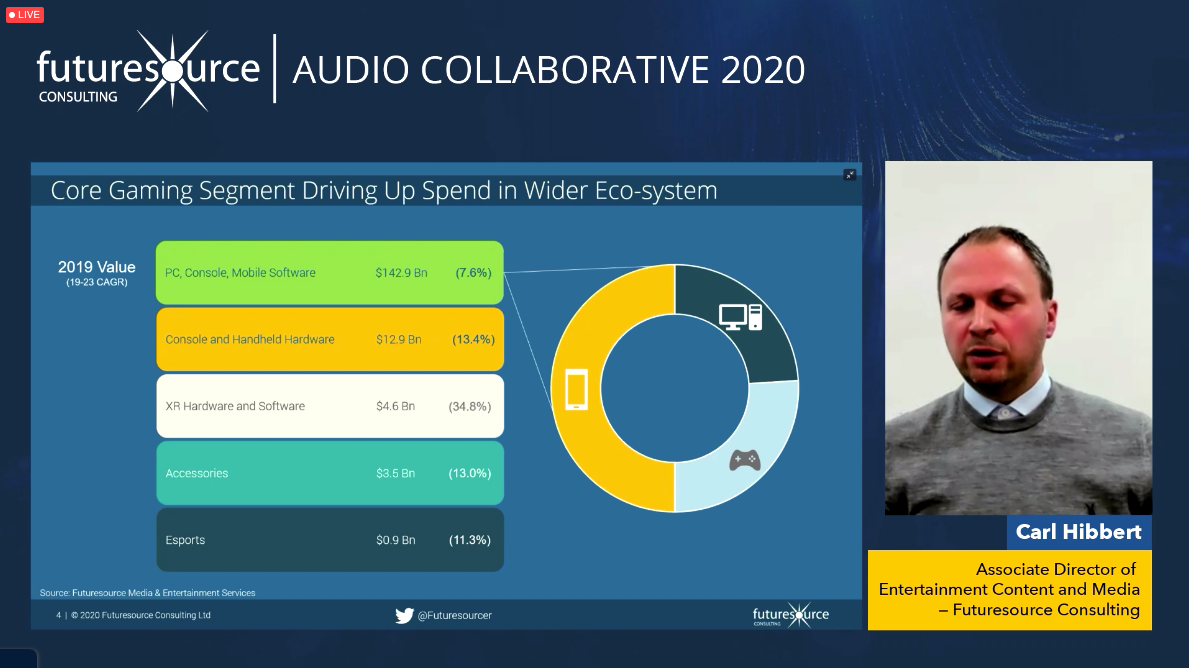
When the level of isolation slows, we’ll start to see renewed attendance at live esports events again, Hibbert continued. Leading esports gamers today, like Ninja, are pushing brands in gaming too — mind you, younger demographics are more and more engaged with this type of star, as opposed to the stars of previous generations. Notably, for our readers here: With this growth in esports comes subsequent growth in audio hardware (e.g., gaming headsets) too.
Gaming shares will only grow, today’s session highlighted. And with that will come brands and media companies piggybacking on the success of this industry.
Accelerated Growth: Live Streaming of Concerts & UGC
James Kirby, market analyst at Futuresource, moderated our next panel featuring Meridith Rojas of Logitech, Jim Odom of PreSonus Audio Electronics and, joining midway through the panel, Katy Templeman-Holmes of Harman.
Despite a huge hit to live events and venues this year, people are sharing more content than ever, Kirby led. This opens up the possibility for accelerated growth of UGC (user-generated content) and livestreaming of events like concerts. The internet has played such a massive role in music distribution, creation and collaboration, Odom agreed. He sees three parts of the confluence and growth of UGC:
- Internet bandwidth is available to many more people today.
- Production tools have gotten easier, simpler and more accessible — usually low cost but, often, free. Training’s simple too. Go peruse the several thousand videos on creating music on PreSonus’s website, for example.
- Everybody is stuck at home. If you had any inkling to create a short movie or music before, you may have had time to explore it during the quarantine.
On the topic of UGC, Rojas discussed applications in which new types of content are being driven. TikTok, for example, has a low barrier to entry. It allows people to create content in a mostly frictionless way, requiring few skills. It opens the door for a lot of content creators, while many just find it cathartic and enjoyable. Thus, the number of content creators this year has quadrupled, Rojas argued.
Kirby transitioned to discuss the livestreaming and event component of the industry. The virtual event boom is becoming somewhat of a supplement to live events in addition to the physical event itself, he added. We’ve learned things during the lockdown that have forced us to be more creative in delivering virtual events. But what’s temporary? What will continue? Rojas feels strongly that, even as we try harder to substitute our live events with virtual ones, it’s not the same. People go to live events (and for music in particular) for the social aspect as much as they do the music. Virtual events are missing the “human element,” but Rojas of course realizes livestreaming and the virtual element will remain. She noted a few creative applications, like concerts held in Twitch, etc.
OK, so there’s increased opportunity for virtual events — but what will stick? Odom questioned. The live-events scene is devastated right now. His argument: Virtual events to supplement it? Great. But to replace it? No way. There’s a huge industry of people trying to figure it out right now — we’re all inventing new tools for livestreaming; but how does a virtual fan interact with other virtual fans? Odom argued, as so many others have this year, that the technical experience has to be better.
Templeman-Holmes countered that remote production has absolutely been realized, as we’ve gotten better at executing live performances remotely. She finds this makes for a more efficient process in time and finances. Templeman-Holmes feels much of this will stick — and anywhere where tech answers people’s desire to be engaged and immersed (sometimes just to escape) is a win.
AV Collaboration Tools & App Usage Skyrocketing During Lockdown
Hello! Steph here again for the second half of the wrapup! I want to talk about my two favorite sessions of this particular day of the Audio Collaborative 2020. The first one I want to chat about really quickly is the panel session titled, “AV Collaboration Tools and App Usage Turbocharged During Lockdown.”
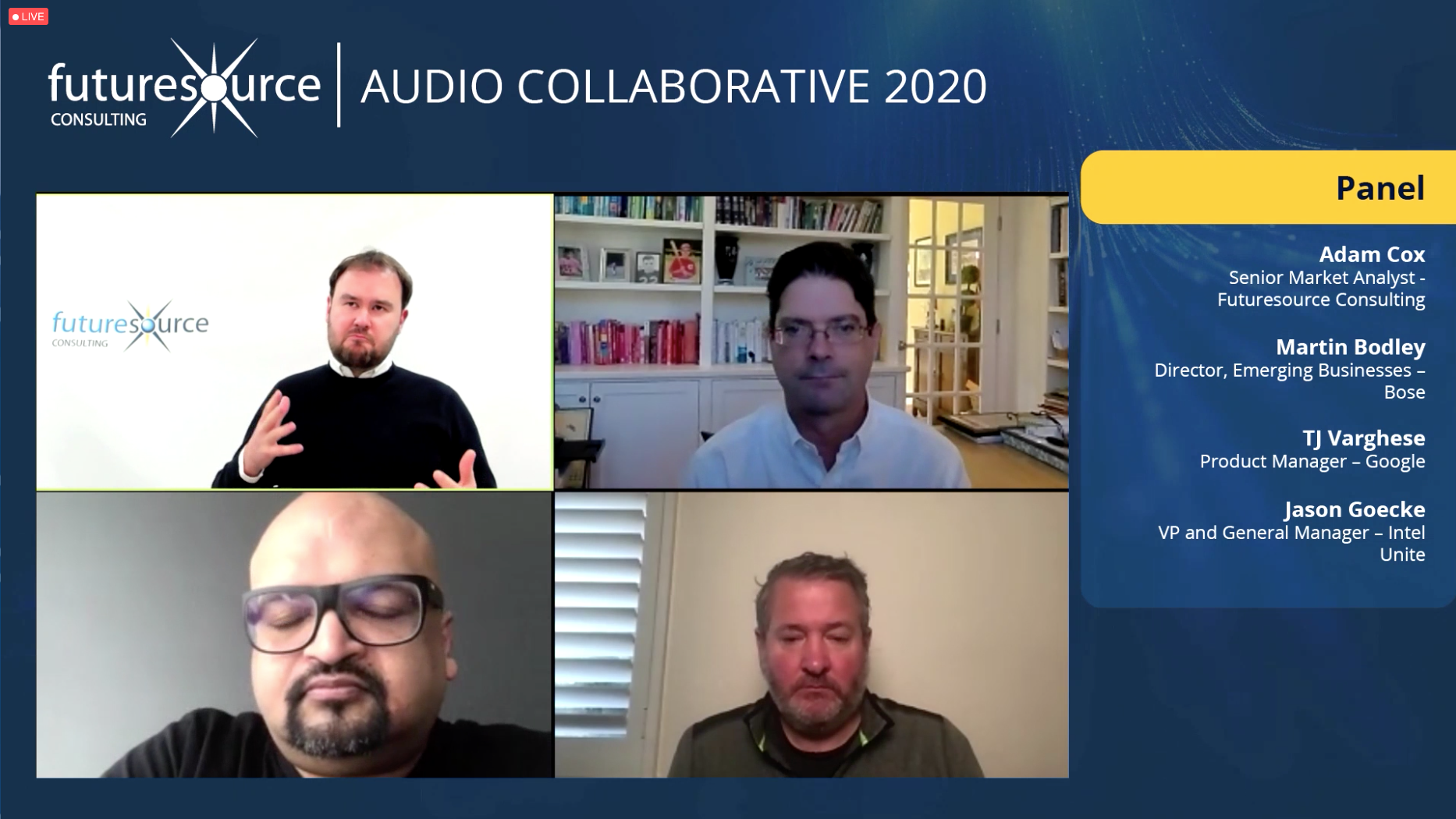
This panel was moderated by Futuresource’s Adam Cox, and included the following panelists:
- Marty Bodley, Director, Emerging Businesses — Bose
- TJ Varghese, Product Manager — Google
- Jason Goecke — VP and General Manager — Intel Unite
The conversation of this portion began simply with opportunity during COVID-19. Y’all are crazy if you don’t recognize that there are opportunities within the tragedy that is COVID. According to Marty (and a report he cited from Frost), the number of people working from home went from 25 million to 150 million. All of those new home workers were and are looking for new technology. So what’s next for those who manufacture and sell that technology? What will work-from-homers want next? Marty says it will likely be things that allow you to shift easily from home to office environments — because people won’t want to come into the office full-time in the (near) future.
Adam also posed the question of how this technology also incorporates audio. Like yes, it’s called videoconferencing. But chances are, you’ll continue a meeting if someone’s video messes up as long as you can hear them. If you can’t hear a person on a video call, though, it’s game over.
TJ stepped up to plate to talk about this one. He said that it’s super important for meetings to have quality audio and for those products to actively work to make people sound natural and remove distracting noises from the background of calls. Basically — you can’t have a videoconference without audio.
Final point I’ll make for this session — the panel talked briefly about what would happen if the pandemic magically ended tomorrow or the next day. Is work-from-home so embedded in our culture that we’ll drag our feet at going back?
The panelists don’t think so. They all pretty much echoed one another’s thoughts and said yeah, the pandemic has lasted for over six months now. But that isn’t long enough for working from home to be ingrained in society. It will be a fair shift back to office life — but working from home will be more heavily relied upon than it ever was pre-COVID. We all know we can do it now, and we know that it works.
OK Boomers — Let’s Learn About TikTok
I know your kids all know what this is: the dreaded TikTok. The app that has taken over society and swallowed us whole. I resisted as long as I could — politely watching the TikToks that others would send me via Safari, but refused to download the app. “It’s the security concerns for me!” I proclaimed.
But like, OK. So another app gets my data. I’m sure it’s not that useful — whoever gets it will just see how long I spend on Twitter. Whoops. ANYWAY — I downloaded TikTok and I literally can’t stop watching them. I am addicted. I’ve started learning the viral dances. My family is worried.
A quick clip capturing the magic of @tiktok_us 🔮 ⬇️
David Saidden, director of strategic partnerships for TikTok, is starting his presentation on Day 2 of #AudioCollaborative2020.
TikTok’s mission ▶️ Inspire creativity and bring joy. #AVtweeps pic.twitter.com/HlX38Z3UqG
— rAVe [PUBS] (@rAVePubs) November 5, 2020
I gave you that backstory to let you know how excited I was that there was an entire session on utilizing TikTok for AV. How cool! I’d like to thank David Saidden for walking us through what this looks like. Here are a few key points:
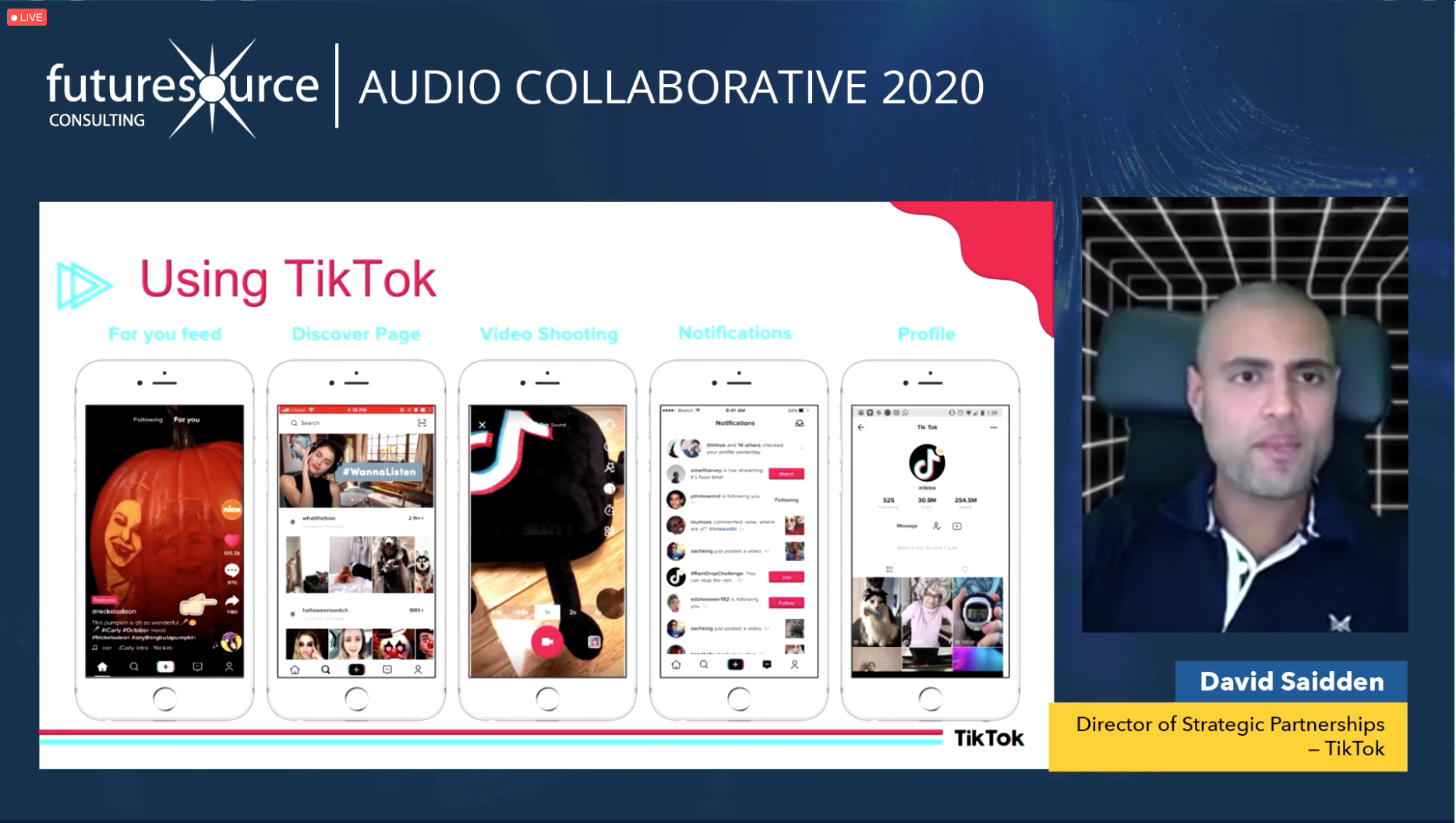
These are what a few of the interfaces look like on the app. There is a lot you can do! And the app recognizes the videos you like, what you watch all of, what you rewatch — then it starts to cultivate recommendations specifically on your app usage. I don’t know what it says about me that all of mine are Twilight-themed.
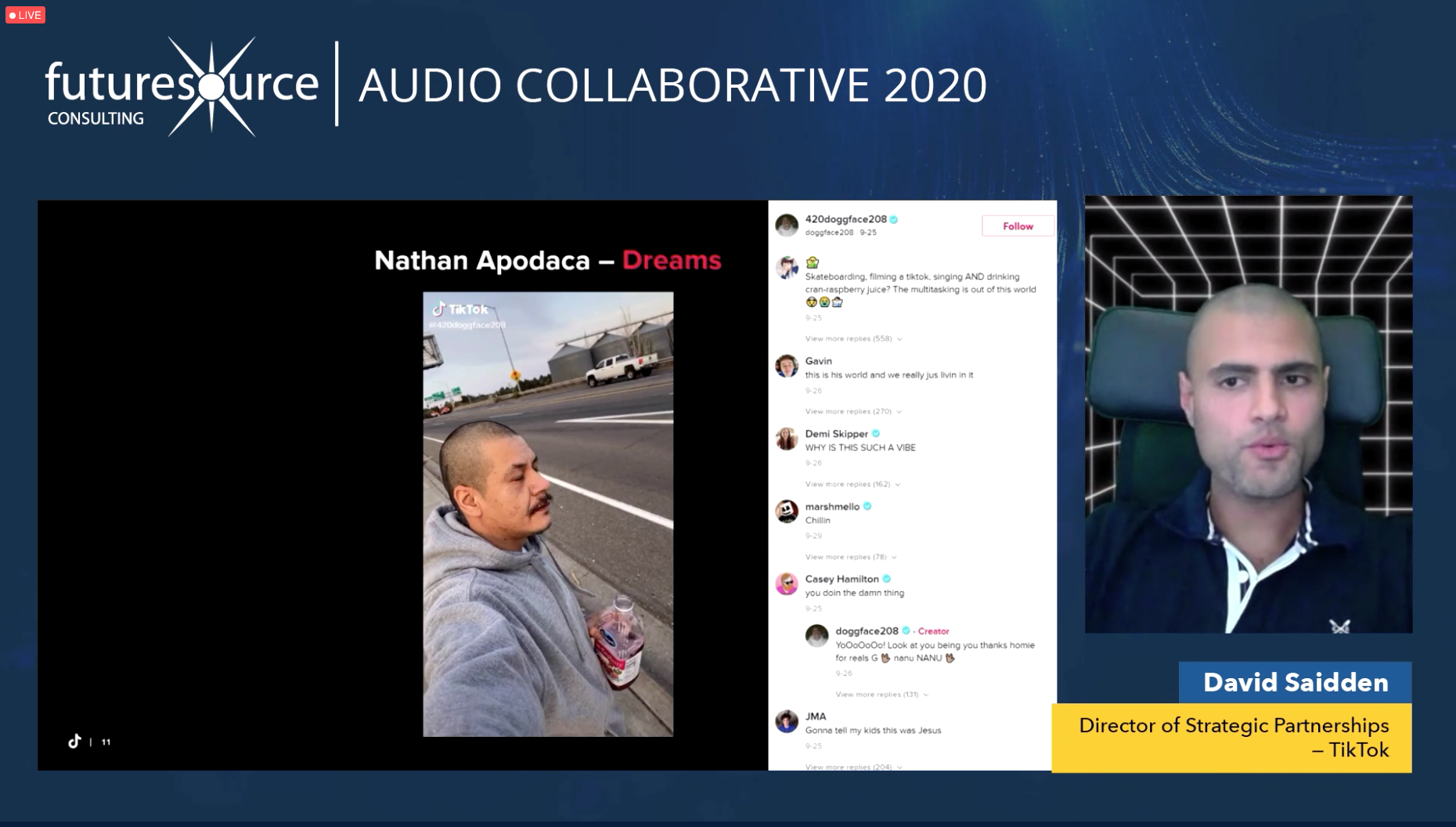
There are a few TikToks that have gone majorly viral like the one above. And with it led to major brand recognition. I don’t know if you all have tried to go to your local Food Lion lately, but the Ocean Spray is pretty much wiped out because of the above video. Dreams by Fleetwood Mac entered Billboard 100 for the first time since the ‘70s. Brands everywhere are trying to have a viral moment like this and TikTok is solidifying itself as an app to make that happen — more than just a video platform for those darn Gen Z kids.
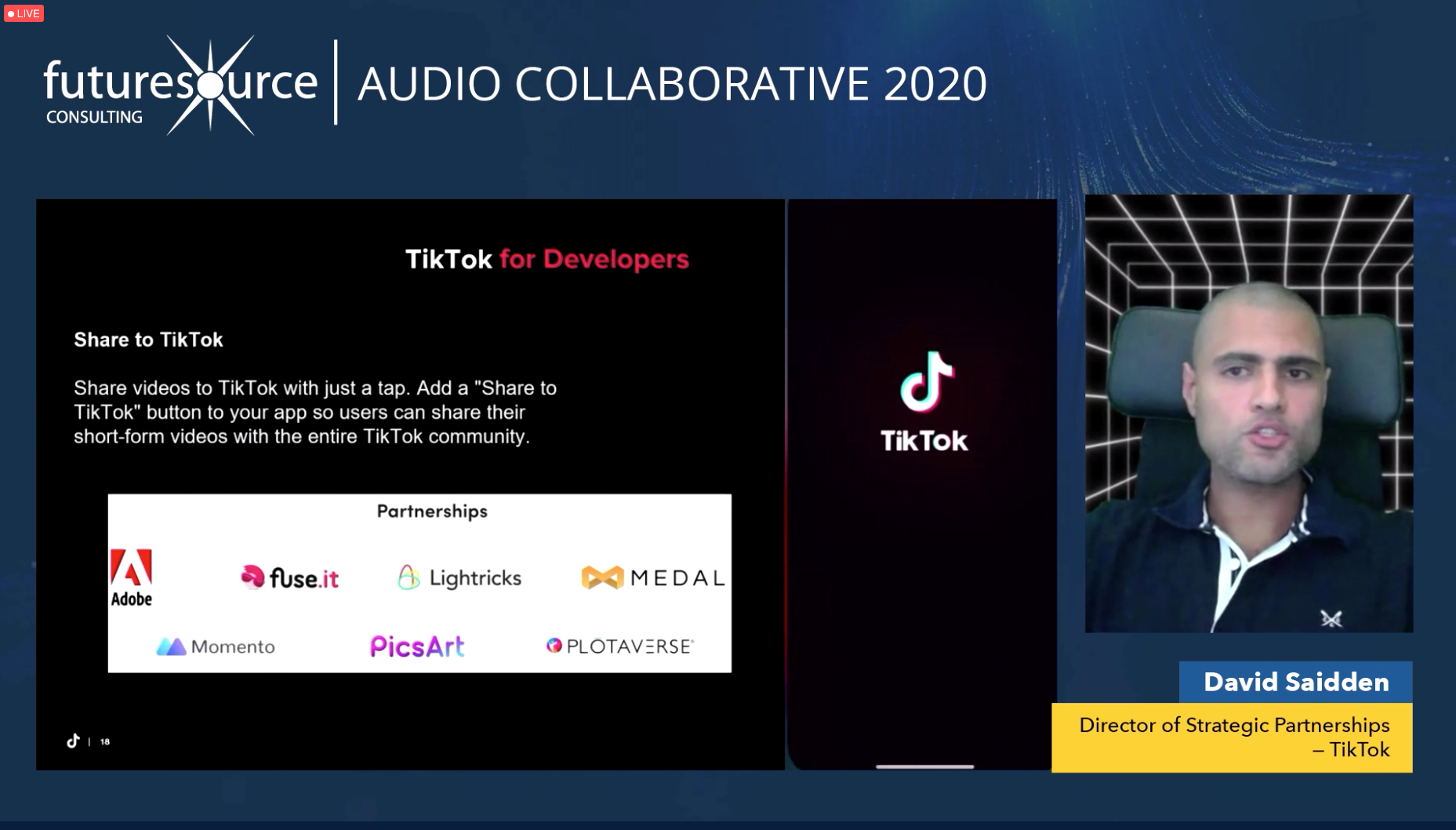
Final point, the app is developing some pretty cool development features because as David mentioned, it wants to expand from being the app that your kids use. And it is! So, definitely stay ahead of the curve and start figuring out how this app can help you and your brand break some new ground.
Recaps & Takeaways
Day Two of Audio Collaborative 2020 — once again — offered a fresh set of insights and content themes around where audio is headed. Some of the themes discussed Thursday:
- Gaming is on the up and up. The market has figured out how to monetize different things and it is WORKING. But there is always room for more growth.
- User-Generated Content is also growing! (Thanks TikTok — we’ll come back to that.)
- The live events market is down right now, but it will never be out.
- People are consuming work-from-home technology right now, but soon there will be a need for technology that can switch between home and office life.
- TikTok is a fun app, yes, but it’s also a great tool for marketing and reaching a new audience.
Thanks for reading our wrapup! The archived content for Audio Collaborative 2020 will be available for an additional six months. Register for Audio Collaborative 2020 here. Also, as seen in the tweets above, you can look at all the live coverage from this event by searching “#AudioCollaborative2020” on social media.





